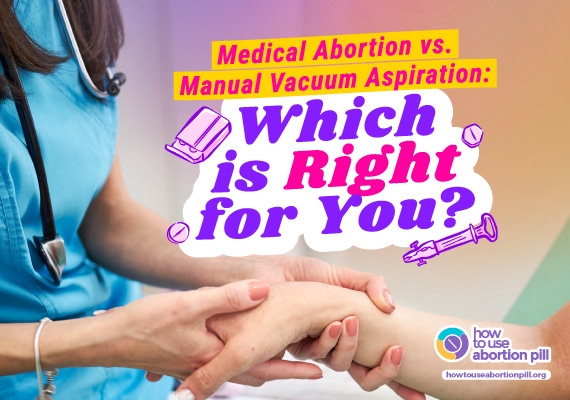The decision to have an abortion is personal and requires careful consideration. One such consideration is deciding what type of abortion to get, either medical abortion or manual vacuum aspiration. Each method carries its own set of advantages and disadvantages, so which is right for you? In this article, we will explore these two methods to help you make the right choice for you.
What are the different types of abortions?
Medical abortion
Medical abortion, often referred to as the abortion pill, uses medications to end a pregnancy. It usually involves using two drugs known as mifepristone and misoprostol.
With a medical abortion, mifepristone is usually the first medication you take, and it works by preventing the pregnancy from growing. It does this by causing the uterine lining to break down, which makes it impossible for the pregnancy to continue.
Misoprostol is the second medication that is taken within 48 hours of taking mifepristone. It causes contractions, helping the body to pass the pregnancy contents from the uterus. This typically causes cramping and bleeding as the uterus empties.
An abortion with pills can also be done using only misoprostol, in case mifepristone is not available. It will need more pills, but is equally safe and effective.
Manual Vacuum Aspiration
A manual vacuum aspiration abortion is conducted by a healthcare provider in a clinic or hospital setting. During this procedure, the provider places a thin tube into the uterus and uses a special syringe to apply suction. As the valve releases, suction helps to remove the pregnancy contents.
Does my length of pregnancy matter?
The duration of your pregnancy can dictate what type of abortion is available to you. The recommendations about timing will vary depending on the facility, provider, and local guidelines. In general, medical abortion is available up to 10 or 12 weeks of gestation, while manual vacuum aspiration is available up to 14 or 15 weeks (if electric vacuum aspiration is also available). Each person should be informed about their options and be able to choose the method that makes them most comfortable.
What are the side effects and risks of each method?
Medical abortions resemble many of the symptoms of an early miscarriage. Such symptoms are common and to be expected, including:
- Cramping
- Heavy bleeding with large clots
- Stomach pain or vomiting
- Diarrhea
- Drowsiness
- Dizziness
Similarly, manual vacuum aspiration can cause irregular bleeding and cramping within the weeks following the procedure.
Both types of abortions carry a very low risk of complications when done correctly. However, the rare potential issues could include:
Medical abortion: heavy or persistent bleeding, infection, blood clots in uterus, incomplete abortion, allergy to medication
Manual vacuum aspiration: heavy bleeding, infection, injury to the cervix, a hole in the uterine wall, incomplete abortion.
All of these complications can be treated with timely medical support. Neither method will affect fertility long-term, meaning the person should be able to get pregnant again in the future.
Why might you choose one method over the other?
When deciding between medical and manual vacuum aspiration abortion, there are a few things you want to think about.
- Stage of Pregnancy: Medical abortion is generally preferred in the early stages, up to 10 weeks. In contrast, medical vacuum aspiration is a method that can be used throughout the first trimester and sometimes beyond.
- Comfort Level: One benefit of medical abortion is the ability to undergo the abortion privately and in the comfort of your own home. However, others may prefer the quick and definitive nature of manual vacuum aspiration abortion.
- Access and Availability: Not everyone has access to a medical vacuum aspiration abortion due to healthcare costs, geographic location, and local regulations. Thus, medical abortion tends to be a more feasible option for those where access is restricted.
Reasons to Choose a Manual Vacuum Aspiration
- You’re in the earlier weeks of pregnancy.
- It avoids the need for surgery and anesthesia.
- It is a more private method.
- It does not always require an in-person office visit.
- It is relatively affordable.
Both abortion methods are safe and highly effective when the right medication is used and all instructions are followed, or when performed by trained professionals and done correctly. By understanding the differences between medical and surgical abortion, you can make an informed decision that aligns with your preferences and health history, ensuring a smooth process from start to finish.
